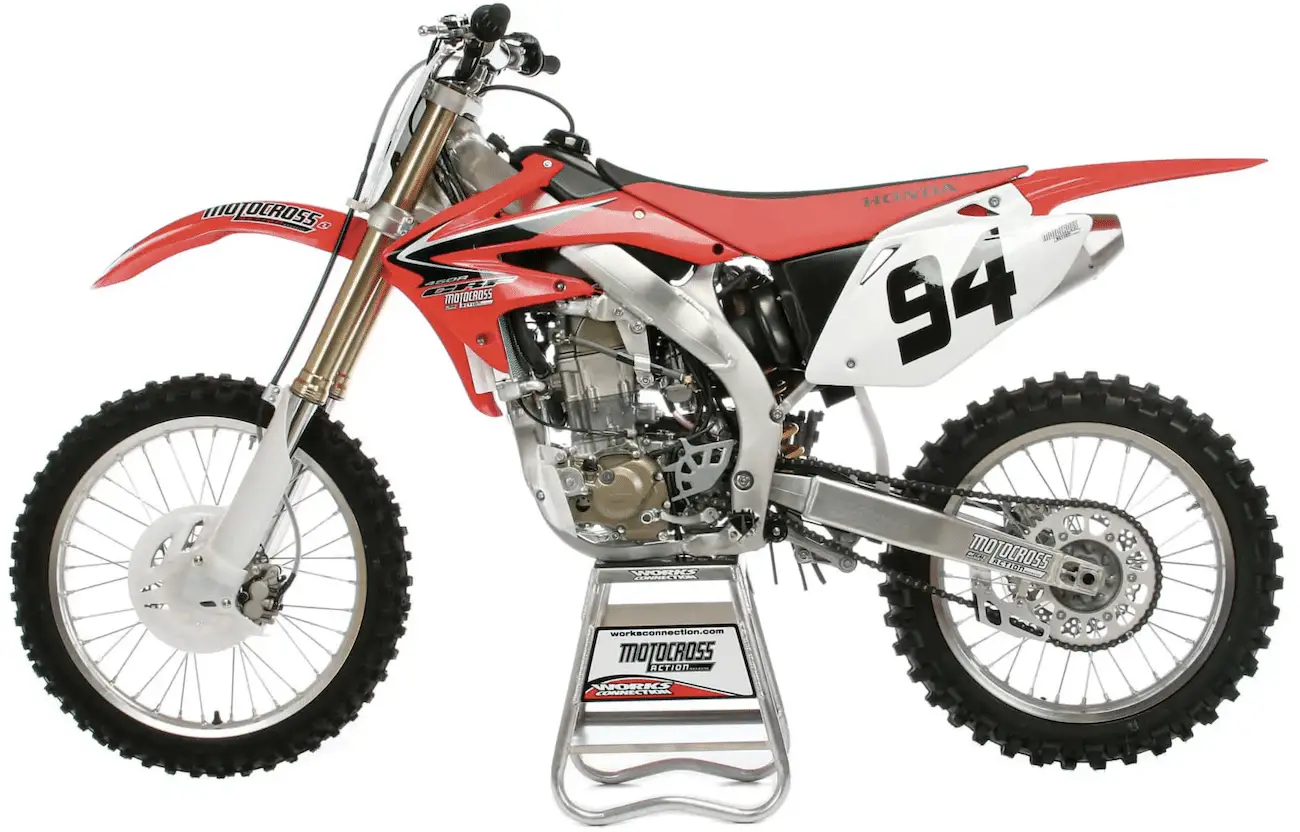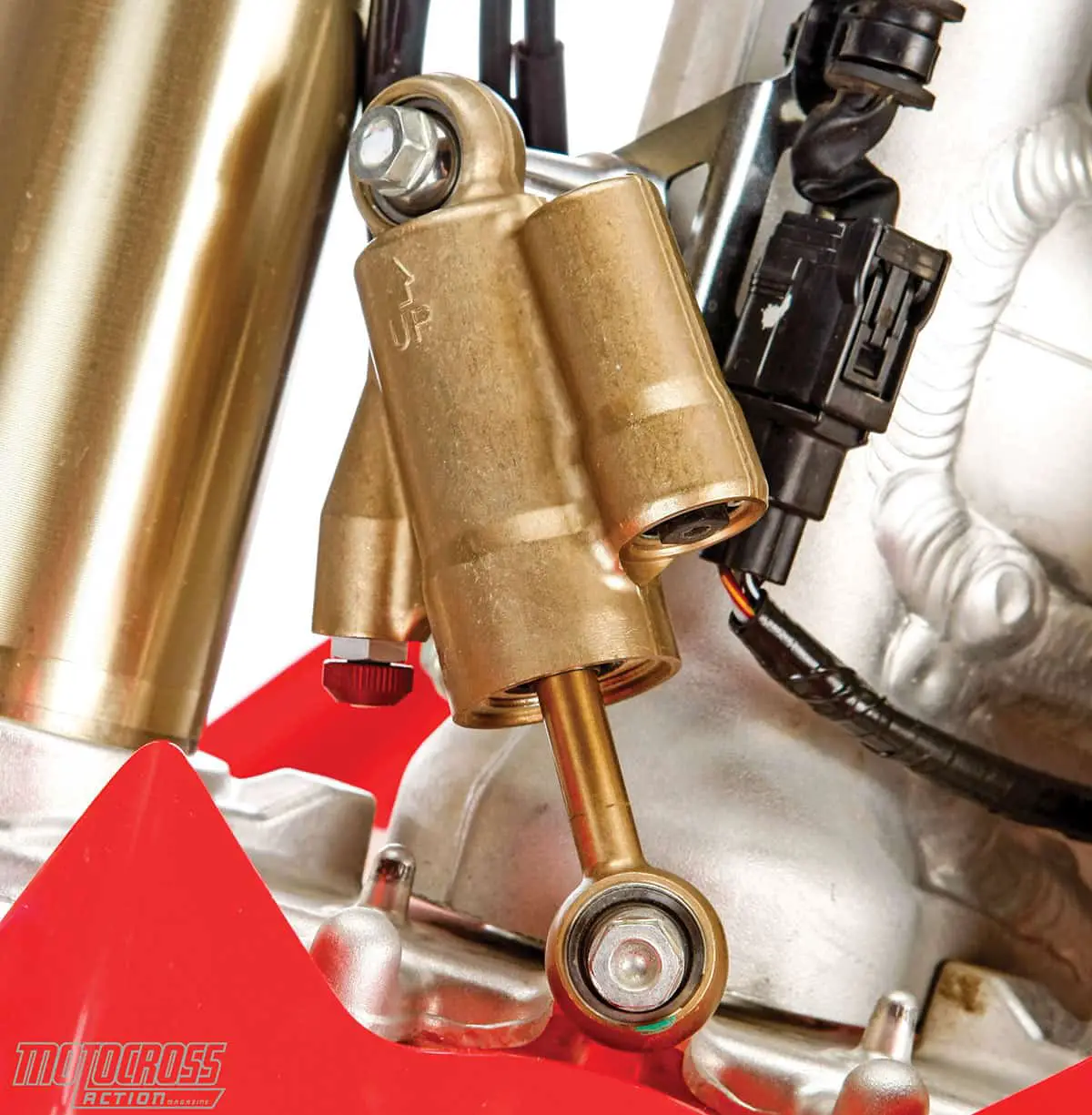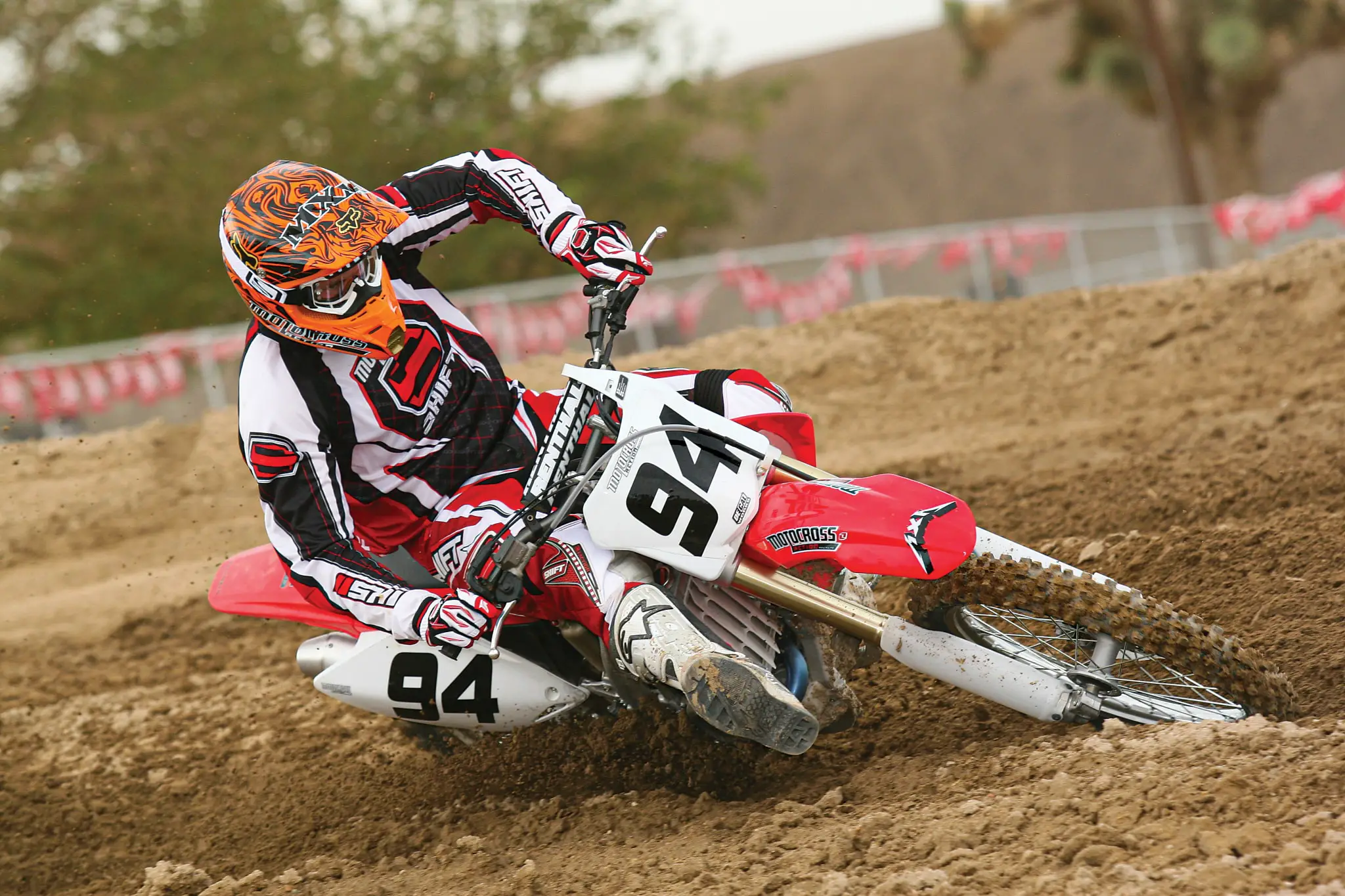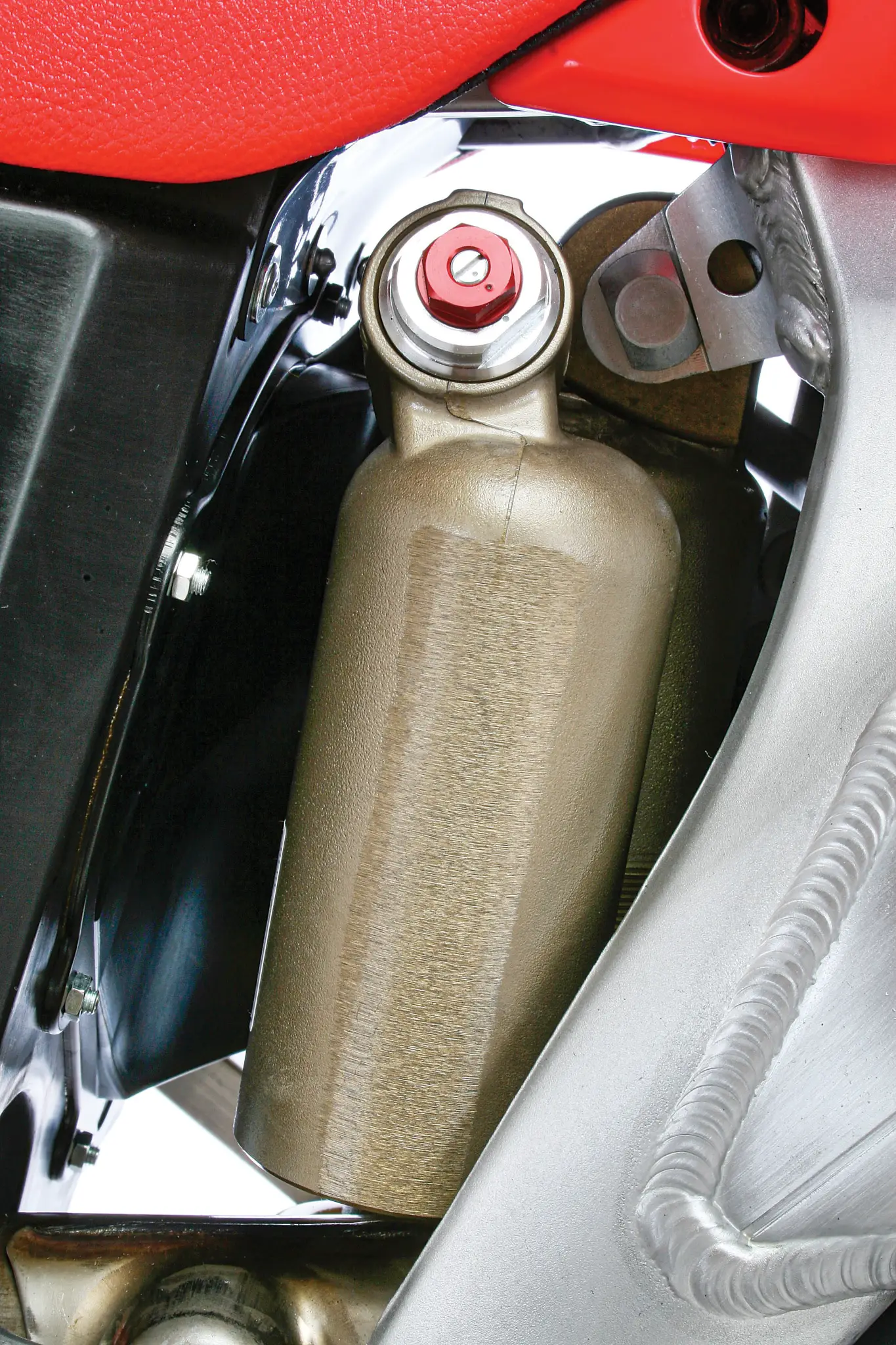MXA RETRO TEST: 2008 HONDA CRF450
We get misty-eyed sometimes thinking about past bikes we loved and those that should remain forgotten. We take you on a trip down memory lane with bike tests that got filed away and disregarded in the MXA archives. We reminisce on a piece of moto history that has been resurrected. Here is MXA’s archived 2008 Honda CRF450 test from the January 2008 issue
 There is a lot of speculation about the revolutionary new 2008 Honda CRF450, but let’s put that to rest right now. The 2008 CRF450 is not new or revolutionary, but it is evolutionary. If we were betting men, we’d plunk down Junior’s college fund that Honda’s engineers plan to blow out the jams on an all-new 2009 CRF450. As much as we like all-new models, they scare us. Too much newness at one time is akin to starting over from scratch.
There is a lot of speculation about the revolutionary new 2008 Honda CRF450, but let’s put that to rest right now. The 2008 CRF450 is not new or revolutionary, but it is evolutionary. If we were betting men, we’d plunk down Junior’s college fund that Honda’s engineers plan to blow out the jams on an all-new 2009 CRF450. As much as we like all-new models, they scare us. Too much newness at one time is akin to starting over from scratch.
The MXA wrecking crew is not ashamed to say that we have loved the last few years of the CRF450 development. After the errors of 2002, 2003 and 2004, the CRF450 has become the industry standard. But, as we stand at the threshold of the 2008 model year, we have to wonder if the 15 changes are enough to keep the product progressing in the right direction.
Q: WHAT ARE THE BUZZ-WORTHY ADDITIONS TO THE 2008 CRF450?
A: Buzz is not the same as a technological improvement. Buzz is word of mouth about potential advancements, not actual enhancements. The buzz on the Honda CRF450 centers on two of the 15 changes.
(1) HPSD. HPSD stands for “Honda Progressive Steering Damper.” Hidden behind the front number plate, Honda’s Showa-built steering damper offers progressive damping beyond the first 5 degrees of direction change (in either direction off the centerline). The damping increases as you turn away from the centerline and decreases as you return towards it. Team Honda has been using the system on some of its works bikes since the days of Ricky Carmichael.
(2) New offset. Since 2002, Honda racers have been changing the triple-clamp offset. Back in 2002, 2003 and 2004, many riders opted for 20mm offset triple clamps instead of the stock 24mm clamps. In 2005, Honda changed the offset by 2mm at the front-axle dropout and steepened the head angle, but most AMA National riders still switched to 22mm triple clamps to complete the deal. For 2006 and 2007, Honda stood pat with their offset, but lowered the engine by 5mm to help forward bite. This improvement in handling lessened the urge to change the offset from stock. Now, suddenly, after six years of the consumer footing the bill for offset changes, Honda has elected to mount 22mm offset triple clamps on the CRF250 and CRF450.
THE MXA WRECKING CREW IS NOT ASHAMED TO SAY THAT WE HAVE LOVED THE LAST FEW YEARS OF THE CRF450 DEVELOPMENT. AFTER THE ERRORS OF 2002, 2003 AND 2004, THE CRF450 HAS BECOME THE INDUSTRY STANDARD.
 Blessed with awesome ergonomics the 2008 CRF450 is comfortable and all the controls are in the right place.
Blessed with awesome ergonomics the 2008 CRF450 is comfortable and all the controls are in the right place.
Q: WHAT DO WE THINK ABOUT HPSD?
A: What did the MXA wrecking crew think of HPSD and the 22mm offset triple clamps? Truthfully, we would rather race a CRF450 with the old 24mm triple clamps and no steering damper. How so? More than half of the MXA test riders didn’t like the feel of Honda’s steering damper. The naysayers described it as feeling like the steering-stem nut was too tight. As a solution, they didn’t just turn the adjustment clicker all the way, but removed the damper from the steerer tube. They claimed that without the damper the CRF450 felt 5 pounds lighter in the corners. The remaining MXA test riders felt that on high-speed tracks, the HPSD cut down on hunting and pecking and the occasional tank slapper.
 The HPSD steering damper is a plus in some situations, but definitely not all.
The HPSD steering damper is a plus in some situations, but definitely not all.
The downside of removing the steering damper was that the 22mm offset triple clamps don’t work all that well with the CRF’s frame geometry without the damper. The front end felt disconnected. It didn’t bite as well in the corners as with the 24mm clamps and had a tendency to be very busy on the entrance to turns. The 2mm offset change moved the engine forward, shortened the wheelbase and increased the trail. We think that Honda changed the offset to justify the steering damper, not the other way around.
Q: IF THE BUZZ WAS A PUSH, WHAT MODS WERE HOT?
A: Of the 15 changes that Honda made to the 2008 CRF450, the majority were minor players in the overall feel of the machine. The 2mm-shorter fork stanchions, 50 rpm more rev, lighter brake rotors, polished fork springs and 0.5mm-larger cartridge rod all contribute to the total package, but aren’t night-and-day differences. So, what changes were?
(1) Ignition maps. We absolutely loved the CRF450’s new CDI system. It came with different ignition curves (maps) for first gear, second gear and third-through-fifth gears. Every test rider could feel the advantages of the special maps. The CRF450 was crisper, torquier and slower-revving, all of which we liked.
(2) Tapered head pipe. In the past, most MXA test riders had to stifle yawns when asked about tapered head pipes, but in a year when “mellow” and “manageable” have become catchphrases for “easier to ride,” a tapered head pipe does deliver on the marketing men’s promises.
 MXA changed the offset of the triple clamps and removed the HPSD damper and the handling was much improved.
MXA changed the offset of the triple clamps and removed the HPSD damper and the handling was much improved.
Q: WHAT DID HONDA CHANGE ON THE 2008 CRF450 ENGINE?
A: This is, by motocross standards, an old engine. Designed in 2002, it has undergone a series of band-aid fixes over the last six years, but nothing earth-shattering.
Here is a brief history:
(1) In 2003, the CRF450 engine got a new cam and new ignition map.
(2) In 2004, the CRF450 got a high-compression piston (12:1), 130-gram-lighter flywheel, 5-gram-lighter piston and two fewer teeth on the rear sprocket (from 50 to 48).
(3) In 2005, the CRF450 got another new ignition map and more air from a new air boot, airbox and air vents.
(4) In 2006, the CRF450 got the more durable valve seats from the 2005 CRF450X.
(5) In 2007, the CRF450 got 30mm exhaust valves (down from 31mm) and a 41mm carb (up from 40mm).
This leads us to the changes to the 2008 CRF450 engine. For 2008, the CRF450 got a new ignition with a gear-position sensor for the three-map CDI, a tapered head pipe, and a lighter counterbalancer shaft and gears.
THE 2008 CRF450 ENGINE IS BETTER FOR THE MAJORITY OF RIDERS WHO PLOP DOWN COLD, HARD CASH TO BUY A CRF450, BUT THE HONDA CRF450 WILL NOT PLEASE PRO RIDERS.
 Thanks to different maps for first, second and third-through-fifth gears, the 2008 CRF450 had a beefier feel.
Thanks to different maps for first, second and third-through-fifth gears, the 2008 CRF450 had a beefier feel.
Q: HOW GOOD IS THE 2008 CRF450 POWERBAND?
A: You might be surprised to learn that, in our dyno runs, the 2008 CRF450 was about 1 horse weaker than the 2007 model from idle to 9500 rpm (and after that, it only matched last year’s model up to the 11,000-rpm sign-off). It didn’t make more power; in fact, it made less. We weren’t surprised. In fact, we are getting used to it. As though by thought control, the engineers at Yamaha, Kawasaki and Honda have all detuned their 450cc powerbands for 2008. Why? To make them easier to ride.
The question isn’t, “Which bike makes the most power?” Rather, “Which one makes the most usable power?” Honda’s engineers did their homework, and while they may have given up horsepower and torque, the 2008 engine feels more powerful and torquier. We credit the tapered head pipe and the three-map ignition. The 2008 CRF450 feels torquier because it revs slower. The slower revving allows the average rider to get more use out of each gear, which means that he has a larger margin of error when it comes to throttle control and shift points.
Q: IS THE 2008 ENGINE BETTER THAN THE 2007 ENGINE?
A: Yes, but there is a caveat—the 2008 CRF450 engine is better for the majority of riders who plop down cold, hard cash to buy a CRF450. It isn’t better for Pro riders who get their bikes for free. Just as with the 2008 YZ450F and KX450F before it, the Honda CRF450 will not please Pro riders. All three 450s gave up Pro-level power for an engine that is easier to ride, better regulated, more metered and able to chug out of corners with less drama.
We liked this powerband. It may lack some of the snap of 2007 and feel a little soft as it goes over the top, but it was more hooked up in every situation. It’s a better engine for the majority of CRF450 buyers.
Q: WHAT ABOUT THE GEARING?
A: Of course, we were tempted to gear it down (by adding 1 tooth to the rear sprocket), but given Honda’s design intent to make the engine feel broader, more hooked up and easier to use, we chose to stick with the stock 48-tooth rear sprocket for most tracks. Slower riders might even want to try 1 less tooth.
Q: WHAT DID HONDA DO TO THE SUSPENSION FOR 2008?
A: Maybe it’s just us, but in our opinion, they wrecked the front forks. Showa had historically produced horrendously harsh forks right up until they outfitted the 2002 CRF450. With the CRF450, Showa’s philosophy and reputation changed. In a single year, Showa miraculously abandoned the mid-stroke harshness that had made them the scourge of Honda riders for decades. Guess what? It’s back. We hated these forks.
Q: WHAT IS THE BEST FIX FOR THE 2007 SHOWA FORKS?
A: We wish we knew. In spite of heroic efforts throughout the ’80s and ’90s, we could never get CR250 forks to be absorbent, plush and resilient. They always jolted to a stop. Even today, the words “mid-stroke harshness” sent us scurrying for a bottle of Advil.
Our quick fix was to lower the oil height by 10cc (actually, we lowered it by 20cc, but had to add 10cc back because the forks became too soft). Shockingly, lowering the oil height only lessened the mid-stroke spike, it didn’t eliminate it. We eventually settled on settings that featured excessive rebound and compression damping in an attempt to keep the forks higher in their stroke. If you are fast, switch to 0.49 fork springs and work with the oil volume to regulate the feel through the mid-stroke, but don’t expect miracles. These forks have problems.
 The 2007 Honda CRF450 was prone to bogging when landing from jumps, but Honda replaced the NJYR needle with a NJGR needle to clean up the jetting for 2008.
The 2007 Honda CRF450 was prone to bogging when landing from jumps, but Honda replaced the NJYR needle with a NJGR needle to clean up the jetting for 2008.
Q: HOW IS THE JETTING?
A: We used to suffer some bogging when landing from jumps, but thanks to a new needle (an NJGR instead of an NJYR) and a richer stock fuel-screw setting, we didn’t have any jetting issues. The stock jetting is as follows:
Main: 178
Pilot: 42
Needle: NJGR
Clip position: Third from top
Fuel screw: 1-5/8 turns
Leak jet: 55
Notes: When temperatures are above 90 degrees, go to a 175; below 60 degrees, use a 180.
Q: WHAT WAS OUR BEST FORK SETTING?
A: For hardcore racing we recommend this fork setup on the 2008 CRF450:
Spring rate: 0.47 kg/mm (0.49 kg/mm for faster riders or tracks with lots of jumps)
Oil height: 398cc (408cc stock)
Compression: 6 clicks out
Rebound: 6 clicks out
Fork-leg height: Flush with the top clamp
Notes: We recommend setting the HPSD steering damper at 7 clicks out as a starting point. Turning the clicker in slows the damping, while turning it out lightens it.
IT’S HARD TO BELIEVE THAT MICHAEL SCHUMACHER, JOHN FORCE, A.J. FOYT OR SIR MALCOLM CAMPBELL EVER TURNED TO THEIR ENGINEERS AND SAID, “IF ONLY YOU COULD SLOW IT DOWN A LITTLE, IT WOULD BE PERFECT.”
 The 2008 shock came with a 5.5 kg/mm shock spring, but felt almost identical to the 2007 shock in motion.
The 2008 shock came with a 5.5 kg/mm shock spring, but felt almost identical to the 2007 shock in motion.
Q: WHAT WAS OUR BEST SHOCK SETTING?
A: The 2008 CRF450 rear suspension is the same as it ever was. Although Honda revalved the shock, the difference between this year and last year’s setup is nil. For hardcore racing, we recommend this shock setup:
Spring rate: 5.5 kg/mm
Race sag: 100mm
High compression: 2 turns out
Low compression: 10 clicks out
Rebound: 10 clicks out
Notes: Honda recommends setting the sag between 100mm and 104mm. Lighter riders should opt for the high side of the scale, while heavier riders will want to crank the race sag up.
Q: WHAT DID WE HATE?
A: The hate list:
(1) Forks. We like retro when it comes to cars, toasters and architecture, but not forks. These forks gave us flashbacks to the ’90s.
(2) Front tire. If you want to get the most out of the 2008 CRF450, remove the Dunlop D742F and replace it with a better front sneaker.
(3) Hot start. We constantly break CRF450 hot-start levers off. Come on Honda, let’s tuck it in.
(4) Rear brake. If you are a brake dragger, that squeal you hear is not from excited fans in the stands.
Q: WHAT DID WE LIKE?
A: The like list:
(1) Handling. We aren’t convinced about the HPSD steering damper, but the CRF450 needs it now (until you mount 24mm offset clamps).
(2) Handlebars. Oversize bars are stronger and more resilient, but some reluctant MXA test rider feels at home behind a set of 7/8-inch bars with a cross bar.
(3) Ergonomics. Honda has the ergonomics dialed. Every part falls readily at hand (or is adjustable enough to satisfy odd tastes).
Q: WHAT DO WE REALLY THINK?
A: It’s hard to believe that Michael Schumacher, John Force, A.J. Foyt or Sir Malcolm Campbell ever turned to their engineers and said, “If only you could slow it down a little, it would be perfect.” But, guess what? It just might have been. But powerband suspension mods are readily available commodities in motocross. That said, the 2008 CRF450 is a really good machine once you make a few choices.






Comments are closed.